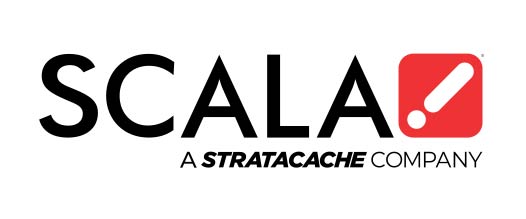External Media Players Offer More Benefits than SoC Displays
by Andrew Veenendaal
External Media Players Offer More Benefits than SoC Displays
by Scala Team
In this blog, we compare SoC digital signage against external media players and see how they stack up against each other.

What is the main difference between an SoC Digital Signage and an External Media Player?
An SoC digital signage is an “all-in-one” display with an integrated processor chip. The integrated chip comes with built-in digital signage software, allowing you to control your on-screen content.
On the other hand, an external media player acts as a small computer that takes content from your digital signage software and displays it on screen. They have a small form factor and can be hidden behind your screens and out of sight.
Comparison Between SoC displays and External Media Players
To help you make the right selection, read on to find out how SoC displays and external media players differ in terms of performance, support, cost, and aesthetics.
Performance
The performance of your content delivery device is critical in ensuring a successful digital signage project.
To display your content effectively, you need to consider what kind of content you are looking for and the importance of delivery speed. While a powerful screen or external device is essential to display more complex content (such as: live data dashboards and 4K videos), something less powerful would be sufficient to display simpler content (for instance: plain text and static images).
For display of rich, dynamic content, the external media player is the clear winner. Tailored to deliver stable multimedia content playback and enable efficient remote monitoring, the external media player is much more reliable and powerful to ensure smooth content display.
SoC displays, on the other hand, tend to fall on the lower side of power and take a much longer content load time
Support
For a digital signage project to be successful, screen uptime is crucial in ensuring that your audience always sees your content. A good support system is therefore essential. How do the different methods of delivering content fare in terms of support?
External media players are well supported and specifically designed for digital signage applications. When support is required, dedicated features built into the software can be used allowing support teams to download software or fix issues remotely. For hardware issues, things remain simple – simply contact your digital signage solutions provider to swap a new player if it cannot be resolved and the screen content will once again be playing.
For SoC digital signage, a limited subset of features is normally available to support software issues and manage them remotely. However, if there is a hardware issue, the entire screen will need replacing, which will incur extra cost.
Cost
For most projects, an external media player is the preferred choice when it comes to cost versus performance. Different hardware and licenses can be selected depending on your unique project requirements, hence ensuring cost efficiency.
Meanwhile, being an all-in-one solution, SoC displays generally have a limited subset of features and capabilities with limited customisation options. Its cost is associated with the benefits like less electricity usage and eco-friendly operations.
The replacement and repair charges for external media players are also lower compared to those for SoC displays.
Aesthetics
In the area of aesthetics, a clean and sleek façade can be achieved with both the external media player and SoC display. An external media player can be hidden nicely behind the screen to give a tidy look. Extra cables can be easily concealed with simple cable management techniques.
On the other hand, SoC displays, being an all-in-one digital signage solution, allows for a completely seamless installation as it comes in a smaller footprint and does not require any additional cables.
External Media Players Bring More Benefits
Based on the above comparison, there is no doubt that external media players deliver more bang for the buck. They also provide other complementary benefits: –
● External media players are more robust, reliable, and built for commercial purposes.
● These media players are more powerful and ideal for delivering complex, multimedia content.
● External media players can be used for in multiple configurations.
● Media players are more cost-effective as there are less associated costs for maintenance, management, and repair.
● External media players allow for easy content changes and adaptations when new features are added to the software.
Scala Media Players: Engineered for Performance, Stability and Reliability
Scala combines decades of digital signage experience with modern technology to provide media players designed for optimum performance. Featuring a slim form factor, Scala media players provide stable multimedia playback and remote monitoring capabilities to support advanced digital signage projects across many industries.
Check out the range of Scala media players here.
About the Author:
Andrew Veenendaal is the




